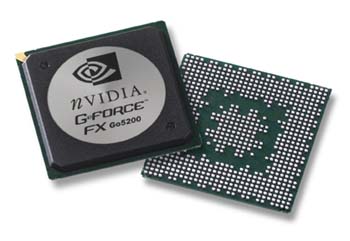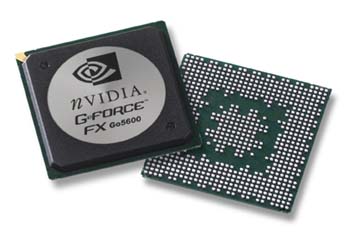The Future of Mobile Gaming: New Chips from ATI and NVIDIA
by Matthew Witheiler on March 13, 2003 8:59 AM EST- Posted in
- Laptops
NVIDIA - GeForce FX Go5200, GeForce FX Go5600, and EA
Like the ATI products announced today, the discrete graphics solutions being announced today by NVIDIA are mobile versions of desktop parts. The first chip is the GeForce FX Go5200, aka NV34M. The GeForce FX Go5200 shares more than just a name with the desktop GeForce FX 5200 unveiled earlier this week. Again, as opposed to going into detail on the NV34 architecture here we ask that you turn back to our discussion of the chip in our GeForce FX 5600/5200 Ultra Performance review. Some key items to keep in mind: that the NV34M is produced on a 0.15 micron process and is a full DX9 part.
The GeForce FX Go5200 graphics processor operates at a 300MHz core clock speed and a 300MHz DDR memory clock speed (600MHz effective). This is slightly less than the 325/325MHz DDR speed which the desktop GeForce FX 5200 Ultra runs at.

The high end solution that NVIDIA is bringing to market today is the GeForce FX Go5600. Based off the desktop GeForce FX 5600 (NV31), the specifications of the Go part are identical to those of the desktop one (which can be seen here). Key features of the NV31M: it is produced on a 0.13 micron process, is a full DX9 part, and shares a number of similarities with the NV30.
The GeForce FX Go5600 comes clocked at a 350MHz core speed and 350MHz DDR memory clock speed (700MHz effective). This is the same clock speed as the desktop GeForce FX 5600 Ultra ships at.

Both the GeForce FX Go5200 and the FX Go5600 incorporate NVIDIA's PowerMizer technology, up to version 3.0 in this incarnation of mobile NVIDIA GPUs. The new PowerMizer shares many similarities with previous generations of the technology; driver implementation of the feature looks almost identical. NVIDIA was able to further gate the GeForce FX Go series processors to reduce power consumption. As a result of this and the smaller manufacturing process, the GeForce FX Go5600 now runs at 1V like the ATI Mobility Radeon 9600.
As derivatives of the NV30 chip, the GeForce FX Go5200 and Go5600 chips include a feature set similar to that offered by the Mobility Radeon 9600 chips. These include component-out support and an MPEG2 encode assist engine. We have not gotten a chance to test either of these features on the GeForce FX line of chips so it remains up in the air how the chips perform in each task.
NVIDIA is also announcing mobile support for a variety of EA games, the first time EA has extended support privileges to a mobile chip. This is is more of a marketing ploy if anything, as the whole line of ATI mobile products should be just as effective at running games produced by EA. The motivating factor behind EA making their support announcement is almost undoubtedly due to the fact that NVIDIA has bought the exclusive distribution rights to some of the existing top EA titles. This means that we should start seeing good games reappear in video card bundles, a welcome addition to any video card purchase.
With the release of two new NVIDIA mobile graphics processors we were left wondering what would become of the GeForce4 4200 Go chip. Initially announced in November of last year it was not until yesterday that we actually saw the GeForce4 4200 Go in a laptop (the Dell Latitude D800), some 4 months later than NVIDIA indicated notebooks would be shipping. It seems that the current plans call for phasing the GeForce4 4200 Go out pretty quickly, with the GeForce FX Go5600 taking over thanks to its superior thermal characteristics and significantly lower power consumption. It is possible that a few more design wins for the GeForce4 4200 Go may pop up in the next week or two, but do not count on it. It seems that the chip was more of a knee jerk reaction to the Mobility Radeon 9000 than a realistic product.










0 Comments
View All Comments